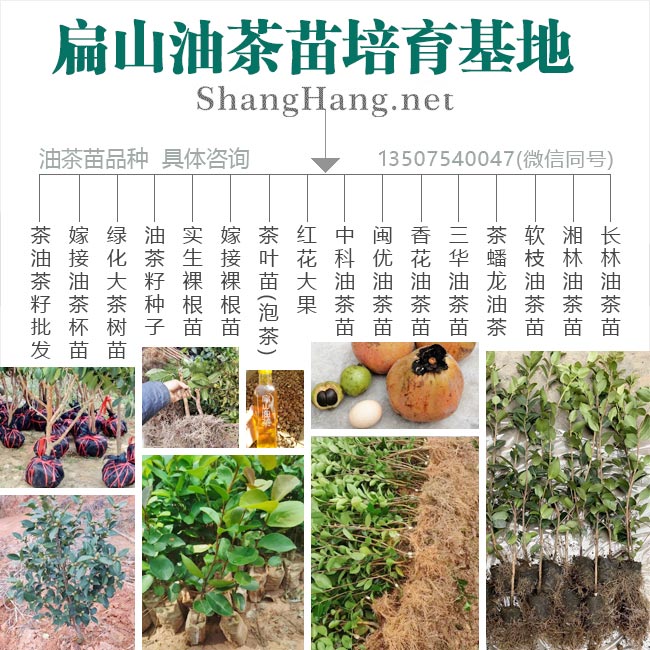XH-2023-2024-Q南寧香花油茶欽州嫁接苗、百色大相當於苗、裸根苗、實生苗香花油(yóu)茶苗栽(zāi)培批發電話1332八738875、貴港香花油茶苗(miáo)掛果多、結果早、產量高、但(dàn)苗的價格會比較貴一些、梧(wú)州、桂(guì)林高產良種(zhǒng)白花茶籽樹苗、香花茶樹苗培育、營養袋裝香花茶樹苗標準30-50CM、50-80公分,一年苗、2年苗、3年苗、5號(hào)苗左右都有,關於價(jià)錢要看(kàn)購買要(yào)求和數量。大型、專業基地,可(kě)開發(fā)票、開三證一簽、種(zhǒng)子苗、實生苗、直生苗、小杯苗培育廣西嫁接(jiē)香花茶樹苗批發9元、長(zhǎng)林、湘林、軟枝油茶苗各品種油茶苗號碼:1號、2號、3號(hào)、4號(hào)、5號、6號、210號、60號、40號、18號...


廣西香花油茶分布於廣(guǎng)西的縉雲、青田、龍泉、遂(suí)昌(chāng)、茶的病害主(zhǔ)要有炭疽病、白粉病、軟腐病、煙煤病等;蟲害主要有介殼蟲、紅蜘蛛、蛀(zhù)莖蛾、茶梢蛾、茶毛蟲、金龜子(zǐ)、葉蜂等。應做到“預防為主、綜合防治”,以營(yíng)林保健種植技術為(wéi)基礎,盡可能采用生物防治方法控製病蟲害的發生(shēng)和蔓延,需(xū)要進行農藥防治時,應使(shǐ)用(yòng)無公害農藥。慶元、鬆陽、雲和扁山大果軟枝紅花湘林長林香花閩優油茶(chá)苗批發網(wǎng)-YouCha、開(kāi)化、常山、仙居,福建的拓榮、霞浦和江西東部的高山上,春季2、3月(yuè)開(kāi)花,9月中、下旬即果實成熟,比其他種類果實的發育周期短,適於中、北亞熱帶地區,海拔香花600~800m的山地種植。海拔(bá)八百米以上,才是采(cǎi)果理(lǐ)想種植(zhí)地區(qū)。廣西香花油茶喜疏鬆(sōng)、肥沃、排水性好(hǎo)的(de)微酸性土壤(rǎng),pH值4.5~7.0範圍內都能(néng)生長,以pH值5.0~6.5較適宜,堿性土壤和地下水位高的地方生長不良。

香花油茶果實成熟時間為9月(yuè)中下(xià)旬,尚(shàng)未成熟的果實采收後出油率(lǜ)低、品質(zhì)差,嚴禁提早(zǎo)采摘;果實成熟的標誌是外果皮絨毛脫落,顏色(sè)變深、色澤變亮;種殼由黃色變為褐色或深黑(hēi)色(sè),種仁變硬,由白色變為黃褐色,有光澤;浙江紅花油茶的果實成熟期正是新(xīn)生花(huā)芽(yá)和葉(yè)芽(yá)含苞期(qī),采收時應使用帶小刀或小鉤的工具,嚴禁折枝采果。果實采回後,應及時日(rì)曬脫粒,除(chú)淨雜物,待其充分幹燥後入庫榨油。

香花種子繁殖秋季應做到隨采隨播,若不能及時播種(zhǒng),應進行濕沙貯藏,笠年2月播種。選(xuǎn)擇地勢平坦、交通便利、土質疏(shū)鬆、灌溉方便、排水良好的土地作苗圃,播種前(qián)進(jìn)行土壤清毒,精耕細作,施足基肥,作好苗床;同時對種子進行消毒、催芽,采(cǎi)用條(tiáo)播方式播(bō)種,幼苗出土後及時加(jiā)強(qiáng)管理。紅(hóng)花油茶主要靠蜂、蟻等昆蟲授粉,一是要保護有益授粉昆蟲,二(èr)是(shì)在林地周圍放養蜜蜂,既可增加經濟收(shōu)入,又能滿足油茶授粉的需要,提(tí)高結實率。

Baise Da is equivalent to seedlings, bare root seedlings, seedlings, high-yield varieties such as Baihua Tea Seed Seedlings, Xianghua Tea Seedlings Cultivation in Guigang, Wuzhou, and Guilin. The standard for nutrient bagged Xianghua Tea Seedlings is 30-50cm, 50-80cm, and can be found in one year, two year, three year, and fifth year seedlings. The price depends on the purchase requirements and quantity. Large and professional base, capable of issuing invoices, issuing three certificates and one signature, cultivating Guangxi grafted fragrant tea seedlings with seed seedlings, seedling, direct seedlings, and small cup seedlings. Wholesale of Guangxi grafted fragrant tea seedlings costs 9 yuan, including Changlin, Xianglin, and soft branch oil tea seedlings. Oil tea seedling numbers: 1, 2, 3, 4, 5, 6, 210, 60, 40, 18
Nanning Xianghua Camellia oleifera Guangxi fragrant camellia oil tea is distributed in Jinyun, Qingtian, Longquan, Suichang, Guangxi. The main diseases of tea include anthracnose, powdery mildew, soft rot, bituminous coal disease, etc; The main pests include crustaceans, red spiders, stem moths, tea tip moths, tea caterpillars, scarabs, leaf bees, etc. Prevention should be prioritized and comprehensive prevention and control should be implemented, based on afforestation and health planting techniques. Biological control methods should be used as much as possible to control the occurrence and spread of pests and diseases. When pesticide control is needed, pollution-free pesticides should be used. Qingyuan, Songyang, Yunhe, Kaihua, Changshan, Xianju, Tuorong and Xiapu in Fujian, and high mountains in eastern Jiangxi. They bloom in February and March in spring and mature in mid to late September, which is shorter than the development cycle of other types of fruits. They are suitable for planting fragrant flowers in mountainous areas with an altitude of 600-800 meters in central and northern subtropical regions. An altitude of over 800 meters is the ideal planting area for fruit picking. Guangxi Xianghua Camellia oleifera prefers loose, fertile, and well drained slightly acidic soil. It can grow in pH values ranging from 4.5 to 7.0, with pH values ranging from 5.0 to 6.5 being the most suitable. Alkaline soil and areas with high groundwater levels are not suitable for growth.

Fruit Maturation Time The ripening time of Xianghua Camellia oleifera fruit is in mid to late September. The immature fruit has a low oil yield and poor quality after harvesting, and early picking is strictly prohibited; The sign of fruit maturity is the shedding of outer skin fuzz, darkening of color, and brightening of color; The seed shell changes from yellow to brown or dark black, the seed kernels become hard, and from white to yellowish brown, with a shiny appearance; The fruit maturity period of Zhejiang safflower camellia is during the budding period of new flower buds and leaf buds. When harvesting, tools with knives or hooks should be used, and it is strictly prohibited to break branches to pick fruits. After the fruit is harvested, it should be threshed in the sun in a timely manner, cleaned of impurities, and stored for oil extraction after it has fully dried.
Camellia oleifera Fragrant flower seeds should be harvested and sown in autumn. If they cannot be sown in a timely manner, they should be stored in wet sand and sown in February of the year. Choose land with flat terrain, convenient transportation, loose soil, convenient irrigation, and good drainage as a nursery. Before sowing, carry out soil detoxification, intensive cultivation, and apply sufficient base fertilizer to make a good seedbed; At the same time, disinfect and accelerate the germination of seeds, use drill sowing method to sow, and strengthen management in a timely manner after the seedlings are unearthed. Red camellia mainly relies on insects such as bees and ants for pollination. Firstly, it is necessary to protect beneficial pollinating insects. Secondly, stocking bees around forest areas can increase economic income, meet the pollination needs of camellia, and improve seed setting rate.

